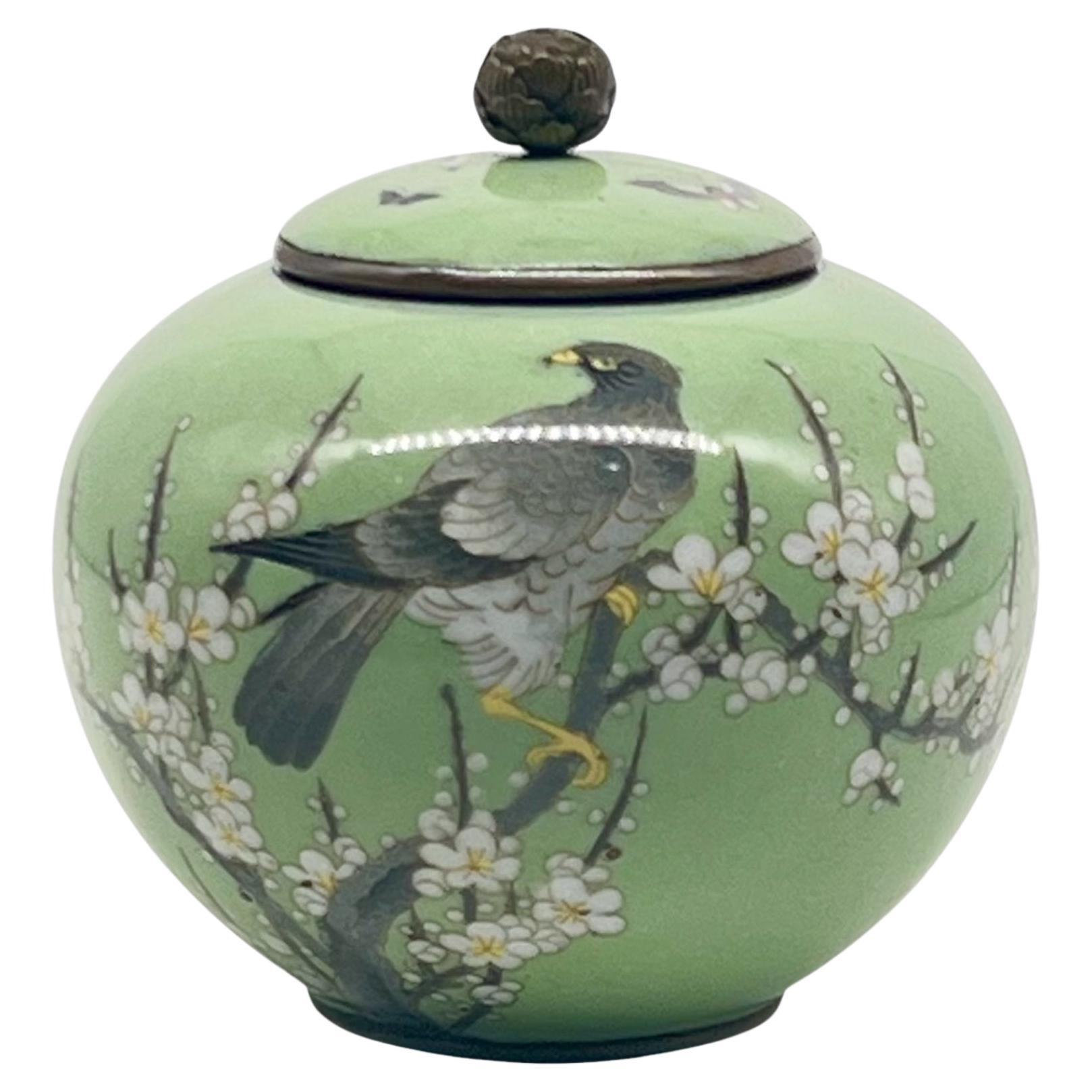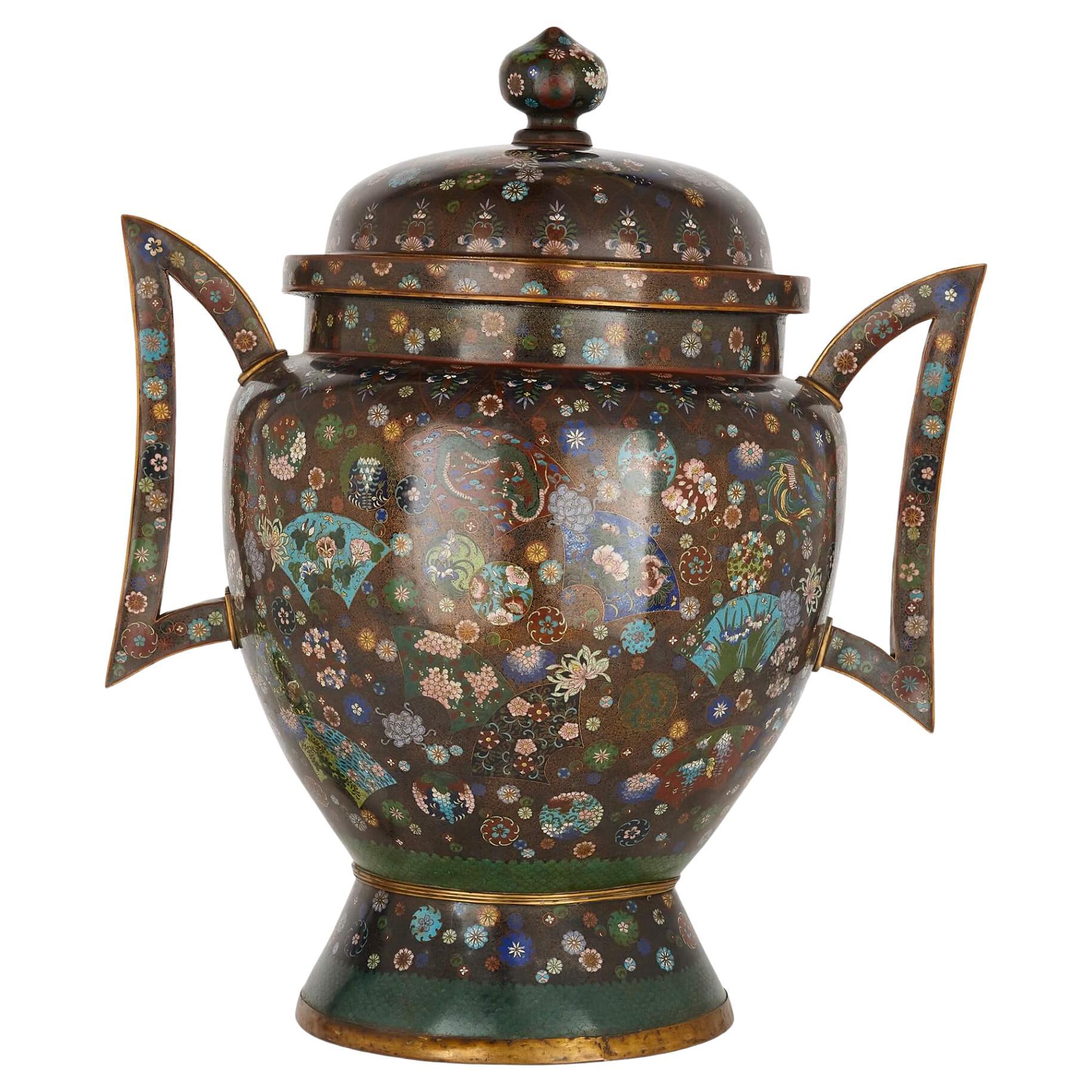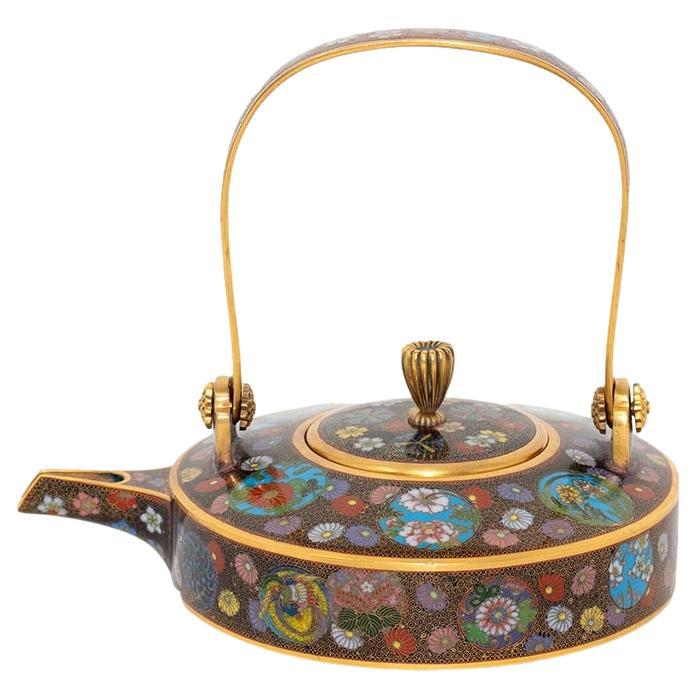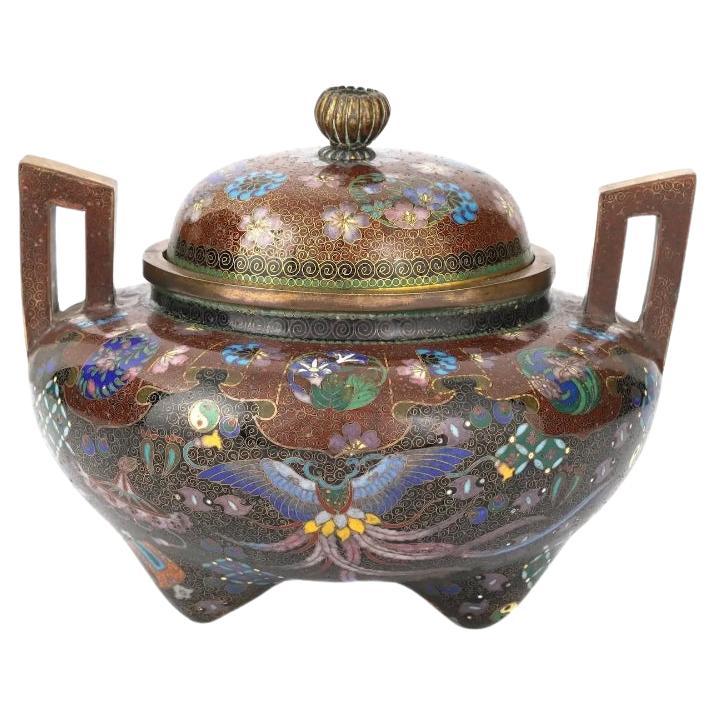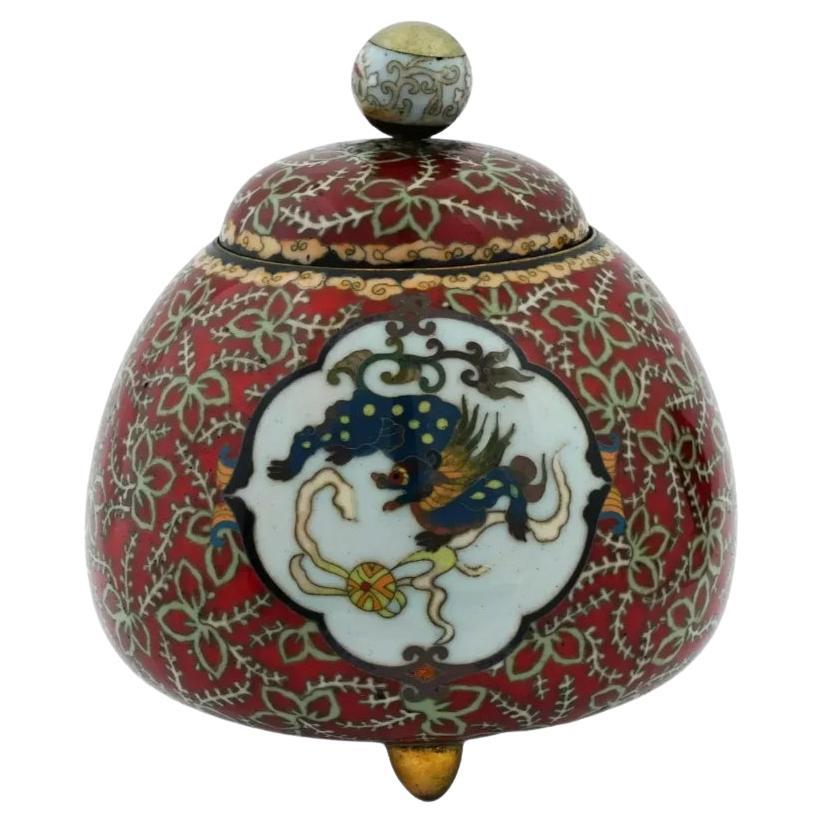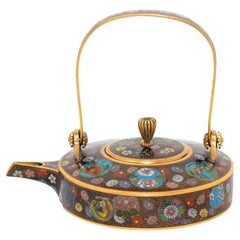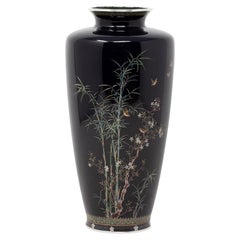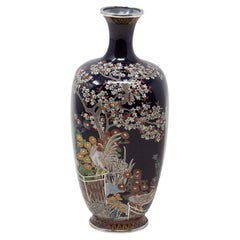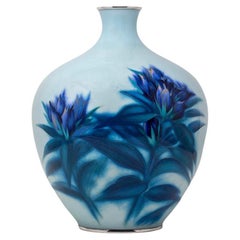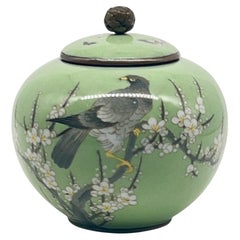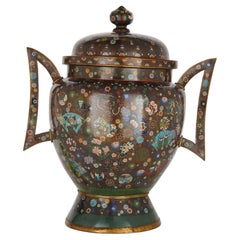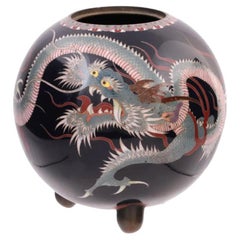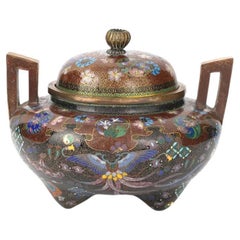Items Similar to Japanese Meiji Period Cloisonne Enamel Koro Tsukamoto Hikokichi
Want more images or videos?
Request additional images or videos from the seller
1 of 20
Japanese Meiji Period Cloisonne Enamel Koro Tsukamoto Hikokichi
$8,232.62
£6,000
€7,068.53
CA$11,324.38
A$12,615.11
CHF 6,654.27
MX$152,962.13
NOK 84,651.94
SEK 78,858.65
DKK 52,783.46
About the Item
Silver Mounted
From our Japanese collection, we are thrilled to offer this Japanese Cloisonne Enamel Koro by Tsukamoto Hikokichi. The Cloisonne Enamel Koro of exceptional quality shaped in bulbous squat form with three looped handles and removable lid raised on three tapered feet. The Koro with a sky blue ground decorated extensively with Ho-o birds to the lid, alternating ginbari panels with twin Ho-o birds and a geometric border with scrolling black enamel lines and silver wire inlay. The feet decorated with scrolling black enamel finished with brass pins to protect the enamel on the surface. The centre of the base is inlaid with the makers signature within a red cartouche for Tsukamoto Hikokichi. The Koro dates to the Meiji Period (1868-1912) circa 1910.
Meiji Period was an era of Japanese history that spanned from 1868 to 1912. It was the first half of the Empire of Japan, when the Japanese people began to build a paradigm of a modern, industrialised nation state and emergent great power, influenced by Western countries and aesthetics. As a result of radically different ideas, the changes to Japan were profound and it affected the social structure, politics, economy, military, and foreign relations across the board. The period corresponded to the reign of Emperor Meiji and was preceded by the Keio era and was succeeded by the Taisho era.
Cultural Art during the Meiji Period was of particular interest to the government and they overhauled the art export market which in turn promoted Japanese arts via various world’s fairs, beginning in Vienna at the world fair in 1873. The government heavily funded the fairs and took an active role organising how Japan’s culture was presented to the world including creating a semi-public company named Kiritsu Kosho Kaisha (First Industrial Manufacturing Company). The Kiritsu Kosho Kaisha was used to promote and commercialise exports of Japanese art and established the Hakurankai Jimukyoku (Exhibition Bureau) to maintain quality standards. For the 1876 Centennial International Exhibition in Philadelphia, the Japanese government created a Centennial Office and sent a special envoy to secure space for the 30,000 items that would be displayed. The Imperial Household also took an active interest in arts and crafts, commissioning works by select artists to be given as gifts for foreign dignitaries further emphasising the high quality and importance of Japanese art. Just before the end of the 19th century in 1890, the Teishitsu Gigeiin (Artist to the Imperial Household) system was created to recognise distinguished artists. These artists were selected for their exceptionally high quality wares and talent in their own industry. Over a period of 54 years Seventy artists were appointed, amongst these were ceramicist Makuzu Kozan and cloisonné enamel artist Namikawa Yasuyuki.
Ginbari is a type of cloisonne with clear enamel over a stippled silver layer applied to the copper sheet body.
Ho-o represents fire, the sun, and the imperial family. It also stands for the virtues of duty, propriety, faith, and mercy. Its five colors represent the five elements of wood, fire, earth, metal, and water. Ho-o came from Chinese mythology, where they are known as fenghuang.
- Creator:Tsukamoto Hikokichi (Maker)
- Dimensions:Height: 3.94 in (10 cm)Diameter: 3.55 in (9 cm)
- Style:Meiji (Of the Period)
- Materials and Techniques:
- Place of Origin:
- Period:
- Date of Manufacture:Circa 1910
- Condition:Wear consistent with age and use.
- Seller Location:Newark, GB
- Reference Number:Seller: IBRDD1stDibs: LU6971245586022
About the Seller
5.0
Gold Seller
Premium sellers maintaining a 4.3+ rating and 24-hour response times
Established in 2019
1stDibs seller since 2022
37 sales on 1stDibs
Typical response time: 2 hours
- ShippingRetrieving quote...Shipping from: Newark, United Kingdom
- Return Policy
Authenticity Guarantee
In the unlikely event there’s an issue with an item’s authenticity, contact us within 1 year for a full refund. DetailsMoney-Back Guarantee
If your item is not as described, is damaged in transit, or does not arrive, contact us within 7 days for a full refund. Details24-Hour Cancellation
You have a 24-hour grace period in which to reconsider your purchase, with no questions asked.Vetted Professional Sellers
Our world-class sellers must adhere to strict standards for service and quality, maintaining the integrity of our listings.Price-Match Guarantee
If you find that a seller listed the same item for a lower price elsewhere, we’ll match it.Trusted Global Delivery
Our best-in-class carrier network provides specialized shipping options worldwide, including custom delivery.More From This Seller
View AllJapanese Meiji Period Cloisonne Enamel Sake Pot
Located in Newark, England
Fine Japanese Meiji period cloisonne enamel Sake pot. The Sake pot of rounded form with with clean edges profusely decorated with blossoming flowers throughout upon a black ground ba...
Category
Antique Late 19th Century Japanese Meiji Metalwork
Materials
Metal, Enamel
Japanese Antique Cloisonne Enamel Vase Hayashi Kodenji
Located in Newark, England
MEIJI PERIOD (1868-1912)
From our Japanese collection, we are delighted to introduce this good size Japanese Cloisonne Enamel Vase. The Vase of gently tapered form with a pinched n...
Category
Antique Early 1900s Japanese Meiji Metalwork
Materials
Gold, Silver, Enamel
Japanese Meiji Period Cloisonne Enamel Vase by Ando Jubei
By Ando Jubei
Located in Newark, England
Free international shipping
Ando Cloisonne Company Mark
From our Japanese collection, we are delighted to introduce this Japanese Cloisonne Enamel Vase by Ando Jubei. The Cloisonn...
Category
Antique Early 1900s Japanese Meiji Metalwork
Materials
Enamel, Wire
Japanese Cloisonné Enamel Vase by Ando Company, Showa Period
By Ando Jubei
Located in Newark, England
Striking Blue Cloisonne Enamel Vase
From our Japanese collection, we’re pleased to offer this cloisonné enamel vase by the Ando Company, dating to the late Showa period, circa 1945....
Category
Mid-20th Century Japanese Showa Vases
Materials
Silver, Enamel
Rare Japanese Meiji Period Moriage Cloisonne Enamel Vase
Located in Newark, England
Very Rare Moriage Netting
From our Japanese collection, we are thrilled to introduce this fine Japanese Moriage Cloisonne Enamel Vase. The Cloisonne Enamel Vase of baluster form wi...
Category
Vintage 1910s Japanese Meiji Vases
Materials
Silver, Enamel
Japanese Antique Meiji Period Satsuma Vase by Kinkozan
By Kinkozan
Located in Newark, England
GLOBULAR FORM MINIATURE VASE
From our Japanese collection, we are delighted to offer this Japanese Satsuma Vase by Kinkozan. The Satsuma Vase made from earthenware pottery is potted...
Category
Antique Early 1900s Japanese Meiji Ceramics
Materials
Ceramic, Earthenware, Pottery
You May Also Like
A Fine Japanese Cloisonne Enamel Koro. Meiji period
Located in London, GB
Japanese Silver Wire Cloisonné Koro with a Bird , butterflies and Floral Design
Meiji Period (1868-1912)
A beautifully executed Meiji-period Japanese cloisonné koro, featuring a...
Category
Antique 19th Century Japanese Metalwork
Materials
Enamel
Large Meiji Period Cloisonne Enamel Koro
Located in London, GB
Large Meiji Period Cloisonne Enamel Koro
Japanese, late 19th Century
Height 88cm, width 76cm, depth 53cm
This superb cloisonne enamel koro was made during...
Category
Antique Late 19th Century Japanese Meiji Metalwork
Materials
Bronze, Enamel
Antique Meiji Japanese Cloisonne Enamel Dragon Censor Koro
Located in Long Island City, NY
An antique Japanese, late Meiji Era, tripod enamel censer koro. The sphere form ware is enameled with a polychrome image of a dragon on a black ground made in the Cloisonne technique...
Category
Antique Late 19th Century Japanese Meiji Metalwork
Materials
Enamel
Large Japanese Cloisonne Enamel Koro Incense Burner with Takara-Mono
Located in Long Island City, NY
A fine quality Japanese cloisonne covered koro or incense burner, Meiji era, 1868 to 1912. The piece features cloisonne handles and cover. The exterior is decorated with various desi...
Category
Antique Late 19th Century Japanese Meiji Metalwork
Materials
Enamel
Antique Japanese Meiji Cloisonne Enamel Red Tripod Jar
Located in Long Island City, NY
An antique Japanese copper lidded jar with polychrome red cloisonne enamel design. Late Meiji period, before 1912. Round shape, lid with globe finial. The piece rests on three feet. ...
Category
Antique Late 19th Century Japanese Meiji Metalwork
Materials
Enamel, Copper
$2,100 Sale Price
30% Off
A Cloisonné hexagonal potiche
Located in Milano, IT
Cloisonné potiche with a hexagonal shape, embellished with delicate floral decorations on reserves held by silver threads with geometric motifs. The lid features a spherical socket.
...
Category
Antique Late 19th Century Japanese Japonisme Metalwork
Materials
Metal
More Ways To Browse
Meiji Period Furniture
Japanese Enamel
Meiji Wood
Meiji Wood Furniture
Arts And Crafts Enamel
Emperor Japan
Meiji Cloisonne Furniture
Meiji Cloisonne
Metal Cloisonne
Japanese Displays Stands
Japanese Silver And Enamel
Japanese Meiji Panel
Enamel Inlay
Meiji Scroll
Chinese Brass And Enamel
Chinese Enamel Metal
Centennial Furniture
Empire Furniture Company Antique
